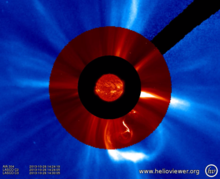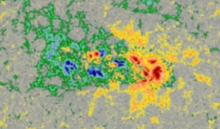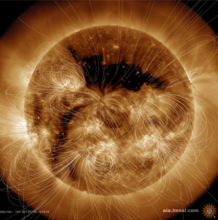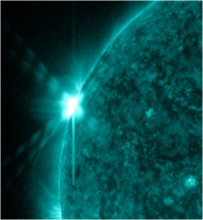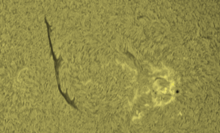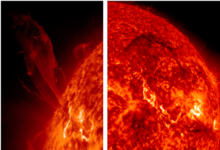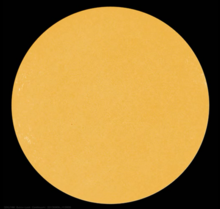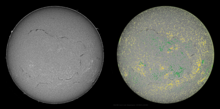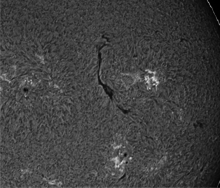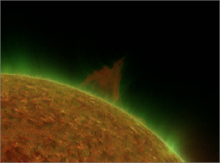news
Submitted on 2013-11-06
Every year, many companies organize activities for their personnel in order to have some fun and to strengthen the team spirit. Late October, some sunspot groups got the same idea. However, their idea of a fun team-building activity was quite different: Together, they wanted to destroy a nearly million km long solar filament. This spectacular movie reveals how they did it.

Submitted on 2013-10-31
No, Beta-Gamma-Delta (BGD) is not some high-school prom reunion, but one of the possible magnetic classifications of a sunspot group. These classifications play a major role in determining whether or not a sunspot group is up to significant flare activity.
Submitted on 2013-10-23
Coronal holes (CH) are regions in the hot solar atmosphere ("corona") where the plasma density at that temperature is very low compared to its surroundings, and thus they look like dark shapes in the corona. Linked to unipolar magnetic fields stretching into space, they are the source of the high-speed solar wind and can create geomagnetic disturbances.
Submitted on 2013-10-16
On 9, 11 and 13 October, the Sun produced an M-class solar flare each day. These three medium-sized eruptions were the first since mid-August, ending a nearly comatose period of solar activity.

Submitted on 2013-10-10
As filaments and filament eruptions continue to determine the current solar activity, it may be an idea to get a bit more acquainted.

Submitted on 2013-10-03
Once again, sunspot and related solar activity was very low last week. Nonetheless, the period featured two very nice eruptions during the evening hours of resp. 24 and 29 September. See this movie. The images underneath show the eruptions as seen with the SDO/AIA 304 filter in extreme ultraviolet (EUV).

The 24 September eruption
Submitted on 2013-09-25
All solar observers and space weather monitors have noticed it: Over the last few weeks, solar activity has dropped again to very low levels.
Submitted on 2013-09-19
A quite impressive filament eruption took place on the Sun's backside on 11 September (see this movie). Solar filaments are clouds of ionized gas above the solar surface squeezed between magnetic regions of opposite polarity. Being cooler and denser than the plasma underneath and their surroundings, they appear as dark lines when seen on the solar disk using special filters.

Submitted on 2013-09-12
Solar filaments are clouds of ionized gas above the solar surface squeezed between magnetic regions of opposite polarity. Being cooler and denser than the plasma underneath and their surroundings, they appear as dark lines when seen on the solar disk using special filters, such as Hydrogen-alpha that shows the "cold" inner atmosphere of the Sun ("chromosphere").
Pages
Zircon - This is a contributing Drupal Theme
Design by
WeebPal.


